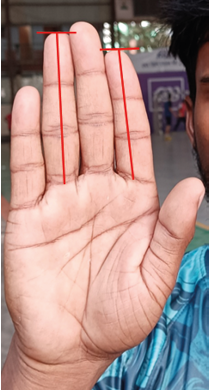
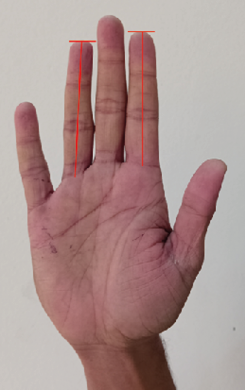
Available online at: https://doi.org/10.18778/1898-6773.87.3.03
 https://orcid.org/0000-0002-0101-8822
https://orcid.org/0000-0002-0101-8822
Department of Physical Education and Sports Sciences, University of Delhi, New Delhi, India
Department of Physical Education and Sports Science, Jashore University of Science and Technology, Jashore, Bangladesh
 https://orcid.org/0000-0003-2334-4394
https://orcid.org/0000-0003-2334-4394
Indira Gandhi Institute of Physical Education and Sports Sciences, University of Delhi, New Delhi, India
ABSTRACT: Hand index, finger ratio, and grip strength are potential indicators of proficiency in court sports. The aim of this study is to explore hand dimensions, fingers length ratio, and grip strength in court sports players, a domain in which such characteristics can significantly influence performance. Measurements, such as hand length (HL), hand breadth (HB), hand index (HI), palm length (PL), hand span (HS), index finger length (2D), ring finger length (4D), 2D to 4D ratio (2D:4D), low digit ratio (LDR), and high digit ratio (HDR) were studied in the field of hand anthropometry, along with a handgrip strength (HGS) test. Data were obtained from 135 male court sports players, including basketball, handball, and volleyball, with 45 players from each discipline. Descriptive statistics, one-way ANOVA, and an independent t-test were used to compare variables, with statistical significance set at p < 0.05. The ANOVA results indicated that there were no significant differences in hand variables, namely HL, HB, PL, HS, 2D, 4D, 2D:4D, LDR, HDR, and HGS, except for the HI variable. Post-hoc test results showed HI differences in basketball versus handball and volleyball. Compared to standard HI, their ranges show that all-court sports often fall into the Dolichocheri type, characterized by long fingers and a narrow, small palm. A low digit ratio may have some effect on HI in basketball and volleyball. However, it does not appear to have a significant effect on HGS across the study. In summary, the results of our study show that court athletes are similar in hand characteristics, 2D:4D, and grip strength for the nature of the game.
KEY WORDS: hand anthropometry, hand index, digit ratio (2D:4D), grip strength, court sports.
Physical characteristics and athletic performance are crucial in court sports, such as basketball, handball, and volleyball, where skillful ball control requires having adequate hand size and grip strength (Rahman and Sharma 2023). In these sports, attributes such as hand length (HL), hand breadth (HB), hand span (HS), finger length, and handgrip strength (HGS)are vital for activities, such as shooting and dribbling in basketball, gripping and catching in handball, and spiking and blocking in volleyball. The elongated fingers of the hand, with extra skin, enhance the efficiency and comfort of gripping objects, such as a ball, by minimizing the need to spread the fingers (Nag et al. 2003). Furthermore, Visnapuu and Jürimäe (2007) suggested that individuals with broad, flat hands and longer fingers might possess a stronger grip. The hand span is used to determine the highest possible handgrip strength values (Ruiz et al. 2006), which helps to grip the ball in hand. In court players, there is a strong link between handgrip strength and general hand anthropometric measures (Apostolidis and Emmanouil 2015; Zapartidis et al. 2016; Kurtoğlu and Çiftçi 2023). The arm is composed of three segments: the upper arm, forearm, and hand (Forro et al. 2023). Hand anthropometry, which involves measuring hand size and finger lengths, especially index and ring finger length, has been correlated with athletic performance in various sports (Manning and Taylor 2001) and the ability to grip and the span of the hand were effective indicators of performance in volleyball players (Faraji et al. 2014). For instance, larger hands can enhance abilities in handling, passing, catching, and serving the ball, thereby greatly influencing individual skills and team strategies in sports where hand usage is key (Blackwell et al. 1999; Barut et al. 2008). In addition, analyzing hand dimensions can provide important insights into an individual’s height, gender, and age (Aboul-Hagag et al. 2011).
In a variety of clinical settings, HGS is commonly evaluated as a gauge of general fitness and upper-limb strength (Nicolay and Walker 2005; Schlüssel et al. 2008). The simplest and most reliable measure of a person’s muscular strength level is their HGS (Lee 2021; Nara et al. 2022), and it can serve as a tool for monitoring cognitive status (Kobus et al. 2021). Hand strength is extremely important in sports that require throwing, catching, and striking, making it a critical factor in the performance of court game athletes. Playing with the ball in court sports requires significant isometric hand grip strength to effectively execute their skills (Wiliński et al. 2022; Reza et al. 2023). The length of the hand has been demonstrated to exert a notable impact on hand strength and play a significant role as a reflective parameter of hand function (Hepping et al. 2015; Wichelhaus et al. 2018). Fallahi and Jadidian (2011) indicated that grip sports, such as handball, basketball, volleyball and baseball are associated with grip strength and anthropometric characteristics of their hands, indicating its potential utility in identifying sports talent. HGS and the 2D:4D ratio are negatively correlated (Zhao et al. 2012; Shen et al. 2016; Lu et al. 2017; Kociuba et al. 2019), whereas HGS shows a positive association with hand dimensions (Mahmoud et al. 2020). Therefore, in relation to hand dimensions including finger length, grip strength, with larger hands and fingers contribute to increased hand stiffness.
The 2D:4D ratio, a tentative biological marker, refers to the proportion between the lengths of the index finger (2D) and the ring finger (4D) on the same hand (Kim and Kim 2016; Fusar-Poli et al. 2021). The digit ratio, or the ratio of the lengths of different fingers, especially the 2D and 4D, is hypothesized to indicate prenatal testosterone (PT) levels, potentially influencing physical and athletic prowess (Manning 2002). Testosterone, a steroid hormone, is decisive for developing and maintaining masculine traits in the human body and is influenced by exposure in the mother’s womb (Mazur and Booth 1998; Islam and Kundu 2019). Masculine characteristics might correlate with a lower ratio of the index to ring digits (2D:4D) (Islam and Kundu 2020a). The growth of the ring finger is significantly influenced by the level of PT hormone in the fetus. Higher testosterone production results in a longer ring finger, leading to a low digit ratio (LDR) (Tomkinson and Dyer 2017). A low 2D:4D ratio is associated with high PT levels and low prenatal estrogen (PE) hormone levels. Conversely, a high 2D:4D ratio indicates lower PT and higher PE levels, leading to a high digit ratio (HDR) (Manning and Fink 2018). Previous research has indicated that individuals with low 2D:4D ratios tend to exhibit superior athletic and physical performance (Kozieł et al. 2024). The 2D:4D ratio, along with other physical and physiological assessments, can play a key role in identifying young sports talent (Islam 2021). In humans, the right-hand 2D:4D is more responsive to prenatal sex hormones than the left (Manning et al. 1998), with the right-hand ratio correlating more strongly with testosterone levels and sperm count. In addition, mean digit ratios remain fairly consistent throughout one’s life (Manning et al. 1998; Manning 2002). Typically, the 4D on a masculine hand (LDR) is about 1 cm longer than the 2D, while in a feminine hand (HDR), the 2D tends to be 1 cm longer than the 4D (Fig. 1.).
 |
 |
| (A) | (B) |
Fig. 1. (A). Masculine hand (LDR), (B). Feminine hand (HDR)
Basketball, handball, and volleyball involve handling a ball on a court, and excelling in these games requires players to use their hands and strength to control the ball. Hand dimensions, including lengths, breadth, span, digit lengths, digit ratio, and grip strength can significantly influence players’ performance. A player’s hand measurements, digit finger ratios, and hand grip strength might be all considerable factors in player selection for team sports involving ball games, in addition to their level of physical fitness. In addition, lower digit-to-finger ratios are linked to more masculine hands and can be indicators of athletic success. Therefore, researchers have looked at these areas in court sports, particularly basketball, handball, and volleyball, to investigate whether there were differences in hand variables, finger length ratios, and grip strength.
This study involved a random selection of 135 male court game athletes, split evenly among three sports: basketball, handball, and volleyball, including 45 players in each discipline. The athletes who did not have any hand abnormalities or injuries were selected for the study. The athletes, aged 17 to 24, who had competed at least at the inter-university level in their respective sports, were selected from ten universities located around Bangladesh.
Table 1 shows that basketball players were significantly taller (177.78 cm) and heavier (71.84 kg) compared to volleyball players (174.26 cm, 68.03 kg) and handball players (170.44 cm, 66.41 kg). In addition, compared to handball players, volleyball players were much taller. Despite these differences, their BMIs were quite similar, usually falling within the 22–23 range.
| Groups | N | Age (yrs) | Height (cm) | Weight (kg) | BMI (kg/m2) |
| Basketball | 45 | 22.04±1.21 | 177.78±6.75 | 71.84±6.75 | 22.72±1.65 |
| Handball | 45 | 21.69±1.68 | 170.44±6.37 | 66.41±7.87 | 22.82±1.92 |
| Volleyball | 45 | 21.82±1.85 | 174.26±7.08 | 68.03±8.66 | 22.38±2.35 |
| Sig. level | 0.57 | 0.00 | 0.00 | 0.56 |
Anthropometric measurements of hand and digit length were taken using the Digital Vernier Caliper (Mitutoyo Corporation, Japan), and HGS was measured with the Hand Grip Dynamometer (JAMAR, USA). HI was calculated by multiplying the HL by hundred, divided by the HB, and the 2D:4D ratio was the length of 2D divided by 4D.
This study’s hand measurements and grip strength data were limited to the right hand only. For hand measurements, all study participants were instructed to place their right hands flat on the table, palms up with fingers extended, except for HB, where the palm downward, fingers together, and thumb stretched out. All measurements of the right hand were taken using a Digital Vernier Caliper. Furthermore, a Hand Grip Dynamometer was used to assess HGS.
HL was gauged from the Mid-stylion (a wrist point) to the Dactylion (middle finger’s tip); ensuring fingers were extended but not overstretched, to determine the hand’s length from wrist to middle fingertip. HB involved measuring from the second metacarpal’s outermost point (index finger base) to the fifth metacarpal’s innermost point (little finger base). Palm length (PL) measurement extended from the wrist’s farthest central crease to the middle finger’s base crease. HS referred to the span between the tips of the thumb and little finger when the hand is perfectly stretched. The 2D and 4D lengths were taken from the basal crease to the fingertip along the medial line of a fully extended hand. All measurements of the hand were recorded using a digital caliper, with the results noted in millimeters (mm).
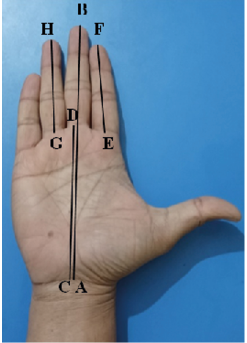 |
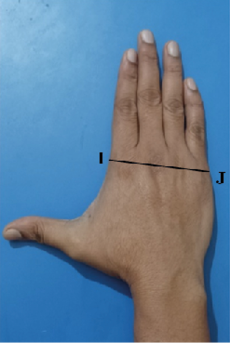 |
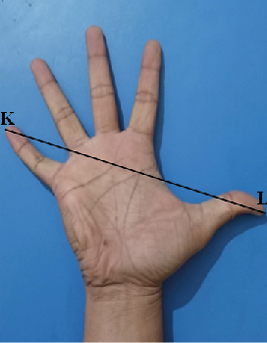 |
Fig. 2. Hand measuring landmarks: HL (A-B), PL (C-D), 2D (E-F), 4D (G-H), HB (I-J), and HS (K-L)
The HI was determined by dividing the HB by the HL and then multiplying the resulting score by hundred. The HI scores were compared using the standard HI and five distinct categories: Hyperdolichocheir, Dolichocheir, Mesocheir, Brachycheir, and Hyperbrachycheir, as defined by Martin and Saller (1957). In this study, the mean HI values of 42.50 for basketball, 43.59 for handball, and 43.50 for volleyball players, often fell into the Dolichocheri type. This type is characterized by long fingers and a narrow, small palm.
To calculate the 2D:4D ratio, the length of 2D is divided by 4D. All court players (N=135) were categorized into LDR and HDR groups based on their 2D:4D ratios, using the quartile deviation method. Those with a digit ratio of 0.951 and below (25% and below) were categorized into the LDR group, while those with 0.987 and above (75% and above) were categorized into the HDR group. Analysis of the quartile deviation revealed distinct groups among basketball, handball, and volleyball players. In basketball (N=24), 9 players were in the LDR and 15 in the HDR group. In handball (N=21), there were 12 LDR and 9 HDR players. Finally, in volleyball (N=26), the distribution was 14 LDR and 12 HDR players.
The handgrip strength of each subject was assessed using the JAMAR hydraulic hand dynamometer. While taking the measurements study participants sat upright and gripped the dynamometer in a comfortable sitting position while keeping their shoulder and elbow at 0° and 90°, respectively. The maximum HGS was automatically recorded in kilograms (kg) by a peak-hold needle. The average score from the three attempts was used as the final score.
Descriptive statistics, an independent t-test, and a one-way ANOVA were employed to compare variables used in this study. Levene’s test showed equal variances, indicating a normal distribution of data. All statistical procedures were conducted using the IBM’s SPSS version 22 for Windows (George and Mallery 2019). Results were considered significant at the p<0.05 level (two-sided).
Table 2 indicates that there were no significant differences between the hand variables, namely HL (F = 1.38, p = 0.26); HB (F = 0.36, p = 0.70); PL (F = 0.07, p = 0.93); HS (F = 0.17, p = 0.85); 2D (F = 0.94, p = 0.39); 4D (F = 0.51, p = 0.60); 2D:4D (F = 0.89, p = 0.42; LDR (F = 0.65, p = 0.53); HDR (F = 0.53, p = 0.59); and HGS (F = 0.50, p = 0.61). However, a significant difference was noted among the groups for the variable HI (F = 3.31, p = 0.047). The result shows that there were no significant differences in various hand measurements and handgrip strength among the groups, except for the HI variable, where a significant difference was found.
| Variables | Groups | N | Mean | Std. Deviation | F-value | p level |
| HL (mm) | Basketball | 45 | 193.29 | 8.76 | 1.38 | n.s. |
| Handball | 45 | 190.38 | 10.28 | |||
| Volleyball | 45 | 190.10 | 11.12 | |||
| HB (mm) | Basketball | 45 | 82.08 | 4.81 | 0.36 | n.s. |
| Handball | 45 | 82.93 | 5.20 | |||
| Volleyball | 45 | 82.54 | 4.21 | |||
| HI (mm) | Basketball | 45 | 42.50 | 2.37 | 3.13 | <0.05 |
| Handball | 45 | 43.59 | 2.14 | |||
| Volleyball | 45 | 43.50 | 2.38 | |||
| PL (mm) | Basketball | 45 | 109.80 | 5.06 | 0.07 | n.s. |
| Handball | 45 | 109.62 | 6.21 | |||
| Volleyball | 45 | 109.35 | 6.31 | |||
| HS (mm) | Basketball | 45 | 215.81 | 11.28 | 0.17 | n.s. |
| Handball | 45 | 214.67 | 12.92 | |||
| Volleyball | 45 | 216.06 | 12.23 | |||
| 2D (mm) | Basketball | 45 | 75.45 | 4.08 | 0.94 | n.s. |
| Handball | 45 | 74.26 | 4.59 | |||
| Volleyball | 45 | 74.33 | 5.14 | |||
| 4D (mm) | Basketball | 45 | 77.50 | 4.22 | 0.51 | n.s. |
| Handball | 45 | 76.88 | 5.04 | |||
| Volleyball | 45 | 76.50 | 5.02 | |||
| 2D:4D | Basketball | 45 | 0.974 | 0.02 | 0.89 | n.s. |
| Handball | 45 | 0.967 | 0.03 | |||
| Volleyball | 45 | 0.972 | 0.03 | |||
| LDR | Basketball | 09 | 0.940 | 0.02 | 0.65 | n.s. |
| Handball | 12 | 0.934 | 0.02 | |||
| Volleyball | 14 | 0.940 | 0.01 | |||
| HDR | Basketball | 15 | 1.000 | 0.01 | 0.53 | n.s. |
| Handball | 09 | 1.003 | 0.01 | |||
| Volleyball | 12 | 1.006 | 0.02 | |||
| HGS (kg) | Basketball | 45 | 48.40 | 8.12 | 0.50 | n.s. |
| Handball | 45 | 49.42 | 7.22 | |||
| Volleyball | 45 | 47.89 | 6.74 | |||
The LSD post-hoc test (Fig. 3) showed that there was a statistically significant difference in the HI between basketball and handball and between basketball and volleyball; however, no significant difference was found between handball and volleyball.
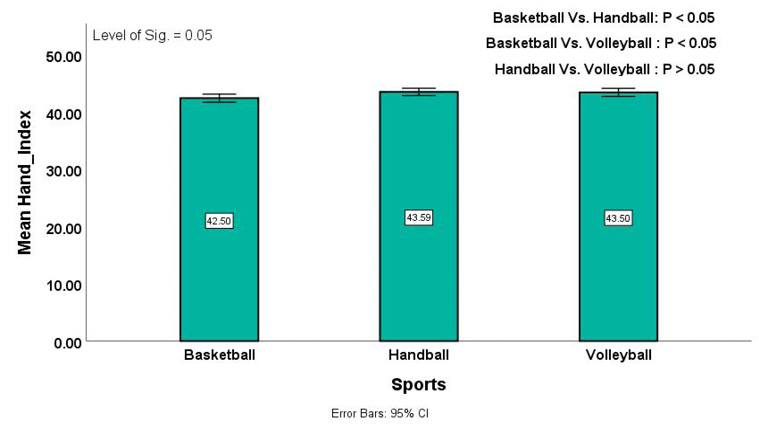
Fig. 3. The difference in the mean value of HI between the three groups
| Groups | Variables | Digit Ratio | N | Mean | Std. Dev. | t | df | p (2-tailed) |
| Basketball | HI | LDR | 9 | 43.37 | 1.57 | 2.36 | 22 | <0.05 |
| HDR | 15 | 41.45 | 2.41 | |||||
| HGS | LDR | 9 | 49.74 | 6.96 | 0.16 | 22 | n.s. | |
| HDR | 15 | 49.11 | 11.90 | |||||
| Handball | HI | LDR | 12 | 43.47 | 2.12 | 0.09 | 19 | n.s. |
| HDR | 9 | 43.55 | 1.60 | |||||
| HGS | LDR | 12 | 50.47 | 5.12 | 1.51 | 16 | n.s. | |
| HDR | 9 | 46.70 | 6.01 | |||||
| Volleyball | HI | LDR | 14 | 44.29 | 3.25 | 2.10 | 22 | <0.05 |
| HDR | 12 | 42.09 | 2.03 | |||||
| HGS | LDR | 14 | 48.26 | 3.67 | 0.07 | 19 | n.s. | |
| HDR | 12 | 48.39 | 5.37 | |||||
The findings in Table 2 suggest that there was not a notable variation in hand measurements and handgrip strength across the groups, except for the HI variable, which exhibited a significant difference. Our study involved court sports players using a cross-sectional design. Findings indicated no notable variations in the width, length, and palm length of the right hand, as well as grip strength. However, significant statistical differences were observed in the hand index values among male basketball, volleyball, and handball athletes (Barut 2008). Basketball players had greater values in right hand length and span compared to volleyball players; however, no significant differences were observed between the two groups (Gaurav et al. 2015). Athletes from different sports, including handball, basketball, and football, exhibit similar levels of hand grip strength (Karakoç et al. 2015). The grip strength of ball game athletes was found to be almost identical (Rahman and Sharma 2023). The grip strength of the dominant hand in males exhibited a tendency to be influenced by hand shape, although the impact was not statistically significant (Bardo et al. 2021). 2D:4D ratios in right hands were compared among non-athletes, volleyball, and soccer players, showing no significant differences (Tomaszewska and Lubońska 2022). Koziel et al. (2016), reported significant differences in mean 2D:4D values among the three distinct male sporting groups on the right hand. The study identified a significant difference in the right 2D:4D ratio between the three groups tested (Kociuba et al. 2022). The present study HI shows that basketball players exhibit differences between handball and volleyball players. In addition, the mean values of court players often fall within the Dolichocheri type, characterized by long fingers and a narrow, short palm. A cross-sectional study of 100 university students, aged 17–26, found that the most common hand index was like that (Sarkodie et al. 2023). The average index for the right hand was 42.83 mm (Chanana and Bandapalle 2022), 43.08 mm (Dey and Kapoor 2017), showing that the hand morphology of male individuals is predominantly categorized as Dolichocheir type (Chia and Anyanwu 2020).
Table 3 revealed significant differences in HI between basketball and volleyball players, while for HGS, no significant differences were found between low and high digit ratios across sports, with the 2D:4D ratio (Table 2) nearly identical in basketball (0.974), handball (0.967), and volleyball (0.972). Ball players with a lower digit ratio have better anthropometric measurements of body composition compared to those exhibiting a higher digit ratio, although the difference is not significant (Islam 2020). Participants in team sports such as soccer (0.965), volleyball (0.969), basketball (0.972), and handball (0.978) generally had higher digit ratios, with the 2D:4D being nearly the same (Malik and Singh 2014). Among ball players, the right-hand 2D:4D ratio showed no significant difference between opposition and cooperative ball players (Ramos et al. 2022). The digit ratio of 108 participants was classified into high (0.973 and above, top 25%, n=28) and low (0.942 and below, bottom 25%, n=28) groups based on quartile deviation (Islam and Kundu 2020b). A low digit ratio is associated with improved endurance and handgrip strength (Ranson et al. 2015; Koziel et al. 2017).
In summary, anthropometric hand measurements, including size, shape, and length, play a crucial role in the strength and precision of hand movements, thereby significantly influencing performance in court games. Because basketball, handball, and volleyball games involve handling a ball, hand anthropometry and grip strength are paramount. Consequently, no notable differences in hand length, digit length, or grip strength were observed among players in the three court games in the present study. This finding aligns with the results reported by numerous previous researchers.
The limitation of the study is that hand measurements and grip strength data were only taken from the right hand. However, expanding the variety of court sports and increasing the sample size both contribute to achieving more accurate results and improved precision by including more measurements. Further research is needed to determine the extent to which these variables relate to performance.
In summary, all court sports athletes were found to exhibit similar hand dimensions, 2D:4D, and HGS, except for the HI. According to HI, basketball players differ between handball and volleyball, and all HI’s were characterized by long fingers and a narrow, short palm. The 4D was significantly higher than the 2D, and the LDR exhibited higher HI values in basketball and volleyball. Regarding HGS, no significant differences were found between low and high digit ratios across sports. Court athletes were similar in hand features and grip strength for the nature of play.
Acknowledgment
The authors express their gratitude to all participants who contributed to the study.
Conflicts of interests
The authors declare no conflicts of interest.
Authors’ contribution
MHR – conceived the idea of the study, collected and analyzed the data, prepared the tables and figures, drafted the manuscript, and revised and finalized the manuscript. JPS – planned and supervised the research, set the goals, provided substantive supervision, and finalized the manuscript.
Aboul-Hagag KE, Mohamed SA, Hilal MA, Mohamed EA. 2011. Determination of sex from hand dimensions and index/ring finger length ratio in upper Egyptians. Egypt J Forensic Sci 1(2):80–86. https://doi.org/10.1016/j.ejfs.2011.03.001
Apostolidis N, Emmanouil Z. 2015. The influence of the anthropometric characteristics and handgrip strength on the technical skills of young basketball players. J Phys Educ Sport 15(2):330–337. https://doi.org/10.7752/jpes.2015.02050
Bardo A, Kivell TL, Town K, Donati G, Ballieux H, Stamate C, Edginton T, Forrester GS. 2021. Get a grip: variation in human hand grip strength and implications for human evolution. Symmetry 13(7):1142. https://doi.org/10.3390/sym13071142
Barut Ç, Demirel P, Kiran S. 2008. Evaluation of hand anthropometric measurements and grip strength in basketball, volleyball and handball players. Anat (Int J Exp Clin Anat) 2:55–59. https://doi.org/10.2399/ana.08.055
Blackwell JR, Kornatz KW, Heath EM. 1999. Effect of grip span on maximal grip force and fatigue of flexor digitorum superficialis. Appl Ergon 30(5):401–405. https://doi.org/10.1016/s0003-6870(98)00055-6
Chanana A, Bandapalle D. 2022. Determining the hand index and hand shape in the population of delhi: a cross-sectional study. Bull Env Pharmacol Life Sci 11(11):199–203.
Chia T, Anyanwu GE. 2020. Anthropometric evaluation of hand dimensions and hand index in a young Nigerian population. Appl Med Res 7(1):1–5. https://doi.org/10.5455/amr.20191119093914
Dey S, Kapoor AK. 2017. Sex determination from hand dimensions for forensic identification. Int J Res Med Sci 3(6):1466–1472. https://doi.org/10.18203/2320-6012.ijrms20150169
Fallahi AA, Jadidian AA. 2011. The effect of hand dimensions, hand shape and some anthropometric characteristics on handgrip strength in male grip athletes and non-athletes. J Hum Kinet 29:151–159. https://doi.org/10.2478/v10078-011-0049-2
Faraji E, Sarvari F, Ebrahimi Atri A. 2014. Predicting grip strength based on anthropometric characteristics in female junior volleyball players. Iran J Health Phys Act 5(1):25–28.
Forro SD, Munjal A, Lowe JB. 2023. Anatomy, shoulder and upper limb, arm structure and function. In StatPearls: StatPearls Publishing.
Fusar-Poli L, Rodolico A, Sturiale S, Carotenuto B, Natale A, Arillotta D, Siafis S, Signorelli MS, Aguglia E. 2021. Second-to-fourth digit ratio (2D:4D) in psychiatric disorders: a systematic review of case-control studies. Clin Psychopharmacol Neurosci 19(1):26–45. https://doi.org/10.9758/cpn.2021.19.1.26
Gaurav DV, Singh M, Singh DS, Singh DA, Sandeep. 2015. A study of hand dimensions and hand grip strength between adolescent basketball and volleyball players. Am Int J Res Humanit Arts Soc Sci 10(3):287–289.
George D, Mallery P. 2019. IBM SPSS Statistics 26 Step by Step: A Simple Guide and Reference. 16th ed. Routledge. https://doi.org/10.4324/9780429056765
Hepping AM, Ploegmakers JJ, Geertzen JH, Bulstra SK, Stevens M. 2015. The influence of hand preference on grip strength in children and adolescents; a cross-sectional study of 2284 children and adolescents. PLoS One 10(11):1–11. https://doi.org/10.1371/journal.pone.0143476
Islam MS, Kundu B. 2019. Digit ratio and soccer. Orthop Sports Med Open Access J 3(1):227–230. https://doi.org/10.32474/OSMOAJ.2019.03.000154
Islam MS, Kundu B. 2020a. Low digit ratio (2D:4D) and masculine attributes: a critical analysis. Int J Res – Granthaalayah 8(7):384–390. https://doi.org/10.29121/granthaalayah.v8.i7.2020.773
Islam MS, Kundu B. 2020b. Soccer passing accuracy differentiates between high and low digit ratio (2D:4D) soccer players. Am J Sports Sci 8(3):49–55. https://doi.org/10.11648/j.ajss.20200803.11
Islam MS. 2020. Digit ratio body composition and motor fitness components as determinants of soccer specific skill performance [Doctoral thesis, Visva-Bharti University]. http://hdl.handle.net/10603/324422
Islam MS. 2021. Low 2D: 4D may reduce the use of doping in sports. Saudi J Sports Med 21(1):33–34. https://doi.org/10.4103/sjsm.sjsm_9_21
Karakoç Ö, Taşkın C, Yüksek S, Özçöven M. 2015. Examining hand grip strength in different sports. Int J Sport Stud 5(10):1132–1136.
Kim TB, Kim KH. 2016. Why is digit ratio correlated to sports performance? J Exerc Rehabil 12(6):515–519. https://doi.org/10.12965/jer.1632862.431
Kobus M, Sitek A, Rosset I, Pruszkowska-Przybylska P, Żądzińska E. 2021. Association of prenatal sex steroid exposure estimated by the digit ratio (2D:4D) with birth weight, BMI and muscle strength in 6– to 13–year-old Polish children. PLoS One 16(10):e0258179. https://doi.org/10.1371/journal.pone.0258179
Kociuba M, Chakraborty R, Ignasiak Z, Kozieł S. 2019. Digit ratio (2D:4D) moderates the change in handgrip strength on an aggressive stimulus: a study among Polish young adults. Early Hum Dev 128:62–68. https://doi.org/10.1016/j.earlhumdev.2018.11.009
Kociuba M, Kulik T, Chakraborty R, Ignasiak Z, Rokita A, Koziel S. 2022. Is digit ratio (2D:4D) associated with a religious profession? An exploratory study on male Polish seminary students. Anthropolo Rev ٨٥(3):95–106. https://doi.org/10.18778/1898-6773.85.3.07
Koziel S, Kociuba M, Ignasiak Z, Chakraborty R. 2016. Is sports choice and participation related to 2D:4D? A study among adult male students in Wrocław, Poland. Coll Antropol 40(2):105–110.
Koziel S, Kociuba MM, Chakraborty R, Ignasiak Z. 2017. Physical fitness and digit ratio (2D:4D) in male students from Wrocław, Poland. Coll Antropol 41(1):31–37.
Kozieł S, Konarski JM, Konarska A, Huechert J, Ignasiak Z, Chakraborty R. 2024. The change in handgrip strength, after physical exercise, is moderated by digit ratio (2D:4D): A study among the young adults in Poland. Am J Hum Biol e24078. https://doi.org/10.1002/ajhb.24078
Kurtoğlu A, Çiftçi R. 2023. Relationship between 2d:4d ratio, handgrip strength, and hamstring muscle length in different sports: a study of volleyball, football and basketball branches. Phys Educ Stud 27(1):17–23. https://doi.org/10.15561/20755279.2023.0103
Lee SY. 2021. Handgrip strength: An irreplaceable indicator of muscle function. Ann Rehabil Med 45(3):167–169. https://doi.org/10.5535/arm.21106
Lu H, Shen D, Wang L, Niu S, Bai C, Ma Z, Huo Z. 2017. Digit ratio (2D:4D) and handgrip strength are correlated in women (but not in men) in Hui ethnicity. Early Hum Dev 109:21–25. https://doi.org/10.1016/j.earlhumdev.2017.04.005
Mahmoud AG, Elhadidy EI, Hamza MS, Mohamed NE. 2020. Determining correlations between hand grip strength and anthropometric measurements in preschool children. J Taibah Univ Med Sci 15(1):75–81. https://doi.org/10.1016/j.jtumed.2020.01.002
Malik A, Singh B. 2014. Digital finger ratio (2d:4d) and salivary testosterone level in elite sportsmen and non-sportsmen. Int J Behav Soc Mov Sci 3(1):1–8. https://doi.org/10.13140/RG.2.2.11572.24969
Manning JT, Fink B. 2018. Digit ratio. In: Shackelford T, Weekes-Shackelford V, editors. Encyclopedia of Evolutionary Psychological Science. Springer, Cham. https://doi.org/10.1007/978-3-319-16999-6_3829-1
Manning JT, Scutt D, Wilson J, Lewis-Jones DI. 1998. The ratio of 2nd to 4th digit length: a predictor of sperm numbers and concentrations of testosterone, luteinizing hormone and oestrogen. Hum Reprod 13(11):3000–3004. https://doi.org/10.1093/humrep/13.11.3000
Manning JT, Taylor RP. 2001. Second to fourth digit ratio and male ability in sport: implications for sexual selection in humans. Evol Hum Behav 22(1):61–69. https://doi.org/10.1016/s1090-5138(00)00063-5
Manning JT. 2002. Digit ratio : A pointer to fertility, behavior, and health. New Brunswick: Rutgers University Press.
Martin R, Saller K. 1957. Lehrbuch der Anthropologie, Dritte Auflage. Vol. II. Stuttgart, Gustav Fischer Verlag.
Mazur A, Booth A. 1998. Testosterone and dominance in men. Behav Brain Sci 21(3):353–397.
Nag A, Nag PK, Desai H. 2003. Hand anthropometry of Indian women. Indian J Med Res 117:260–269.
Nara K, Kumar P, Rathee R, Kumar S, Pal Ahlawat R, Sharma JP, Singh S. 2022. Grip strength performance as a determinant of body composition, muscular strength and cardiovascular endurance. J Phys Educ Sport 22(7):1618-1625. https://doi.org/10.7752/jpes.2022.07203
Nicolay CW, Walker AL. 2005. Grip strength and endurance: Influences of anthropometric variation, hand dominance, and gender. Int J Ind Ergon 35(7):605–618. https://doi.org/10.1016/j.ergon.2005.01.007
Rahman MH, Sharma JP. 2023. An assessment of maximal isometric hand grip strength and upper body explosive strength and endurance in various ball sports. Phys Educ Theory Methodol 23(6):932–939. https://doi.org/10.17309/tmfv.2023.6.16
Ramos S, García A, Ayala F, Álzate D, Aguirre-Loaiza H. 2022. Variation of digit ratio (2D:4D) in athletes and differences with sports groups. J Sport Health Res 14(3):453–464. https://doi.org/10.58727/jshr.87631
Ranson R, Stratton G, Taylor SR. 2015. Digit ratio (2D:4D) and physical fitness (Eurofit test battery) in school children. Early Hum Dev 91(5):327-331. https://doi.org/10.1016/j.earlhumdev.2015.03.005
Reza MN, Rahman MH, Islam MS, Gayen A. 2023. An examination of audio-visual simple reaction times in selected court games. Aust J Basic Appl Sci 17(1):9–14. https://doi.org/10.22587/ajbas.2023.17.1.2
Ruiz JR, España-Romero V, Ortega FB, Sjöström M, Castillo MJ, Gutierrez A. 2006. Hand span influences optimal grip span in male and female teenagers. J Hand Surg 31(8):1367–1372. https://doi.org/10.1016/j.jhsa.2006.06.014
Sarkodie FK, Adjei BM, Tetteh J, Bimpong S, Nketsiah J, Adjei-Antwi C, Abaidoo CS. 2023. A preliminary anthropometric study on second digit: fourth digit (2D:4D) ratio and other hand dimensions for sex determination. Forensic Sci Int Rep 7:1–6. https://doi.org/10.1016/j.fsir.2023.100320
Schlüssel MM, dos Anjos LA, de Vasconcellos MT, Kac G. 2008. Reference values of handgrip dynamometry of healthy adults: a population-based study. Clin Nutr 27(4):601–607. https://doi.org/10.1016/j.clnu.2008.04.004
Shen D, Ma Z, Wang L, Huo Z, Lu H, Zhao J, Qian W. 2016. Digit ratio (2D:4D) and handgrip strength in a Chinese population of Han ethnicity. Early Hum Dev 103:141–145. https://doi.org/10.1016/j.earlhumdev.2016.09.014
Tomaszewska A, Lubońska JA. 2022. 2D: 4D digit ratio and its relationship to BMI, sporting choices and physiological predispositions among women. Anthropol Rev 85(2):135–146. https://doi.org/10.18778/1898-6773.85.2.07
Tomkinson G, Dyer M. 2017. Finger size does matter… in sports. Educ Health Behav Stud Fac Publ 23. https://commons.und.edu/ehb-fac/23
Visnapuu M, Jürimäe T. 2007. Handgrip strength and hand dimensions in young handball and basketball players. J Strength Cond Res 21(3):923–929. https://doi.org/10.1519/1533-4287(2007)21[923:HSAHDI]2.0.CO;2
Wichelhaus A, Harms C, Neumann J, Ziegler S, Kundt G, Prommersberger KJ, Mühldorfer-Fodor M. 2018. Parameters influencing hand grip strength measured with the manugraphy system. BMC Musculoskelet Disord 19(54):1–10. https://doi.org/10.1186/s12891-018-1971-4
Wiliński W, Struzik A, Rokita A, Krejci M, Wieczorek M. 2022. Hand grip strength vs. locomotor efficiency in sitting volleyball players. J Hum Kinetics 82:275–282. https://doi.org/10.2478/hukin-2022-0081
Zapartidis I, Palamas A, Papa M, Tsakalou L, Kotsampouikidou Z. 2016. Relationship among anthropometric characteristics, handgrip strength and throwing velocity in adolescent handball players. J Phys Educ Sports Manag 3(1):127–139. https://doi.org/10.15640/jpesm.v3n1a9
Zhao D, Li B, Yu K, Zheng L. 2012. Digit ratio (2D:4D) and handgrip strength in subjects of Han ethnicity: impact of sex and age. Am J Phys Anthropol 149(2):266–271. https://doi.org/10.1002/ajpa.22130

